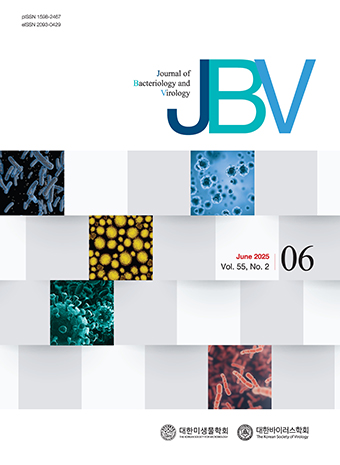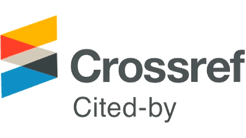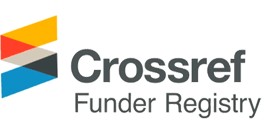Original Article
Weitzel T, Dittrich S, López J, Phuklia W, Martinez-Valdebenito C, Velásquez K, et al. Endemic Scrub Typhus in South America. N Engl J Med. 2016;375(10):954-961.
10.1056/NEJMoa160365727602667Kim G, Ha NY, Min CK, Kim HI, Yen NT, Lee KH, et al. Diversification of Orientia tsutsugamushi genotypes by intragenic recombination and their potential expansion in endemic areas. Plos Negl Trop Dis. 2017;11(3):e0005408.
10.1371/journal.pntd.000540828248956PMC5348041Ponnusamy L, Willcox AC, Roe RM, Davidson SA, Linsuwanon P, Schuster AL, et al. Bacterial microbiome of the chigger mite Leptotrombidium imphalum varies by life stage and infection with the scrub typhus pathogen Orientia tsutsugamushi. PLoS One. 2018;13(12):e0208327.
10.1371/journal.pone.020832730521561PMC6283546Walker DH. Scrub Typhus - Scientific Neglect, Ever-Widening Impact. N Engl J Med. 2016;375(10):913-915.
10.1056/NEJMp160849927602663Richards AL, Jiang J. Scrub typhus: Historic perspective and current status of the worldwide presence of Orientia species. Trop Med Infect Dis. 2020;5(2):49.
10.3390/tropicalmed502004932244598PMC7344502Kala D, Gupta S, Nagraik R, Verma V, Thakur A, Kaushal A. Diagnosis of scrub typhus: recent advancements and challenges. 3 Biotech. 2020;10(9):396.
10.1007/s13205-020-02389-w32834918PMC7431554Xu G, Walker DH, Jupiter D, Melby PC, Arcari CM. A review of the global epidemiology of scrub typhus. PLoS Negl Trop Dis. 2017;11(11):e0006062.
10.1371/journal.pntd.000606229099844PMC5687757Jiang J, Richards AL. Scrub typhus: No longer restricted to the Tsutsugamushi triangle. Trop Med Infect Dis. 2018;3(1):11.
10.3390/tropicalmed301001130274409PMC6136623Cosson JF, Galan M, Bard E, Razzauti M, Bernard M, Morand S, et al. Detection of Orientia sp. DNA in rodents from Asia, West Africa and Europe. Parasit Vectors. 2015;8(1):172.
10.1186/s13071-015-0784-725884521PMC4374543Masakhwe C, Linsuwanon P, Kimita G, Mutai B, Leepitakrat S, Yalwala S, et al. Identification and characterization of Orientia chuto in trombiculid chigger mites collected from wild rodents in Kenya. J Clin Microbiol. 2018;56(12):e01124-18.
10.1128/JCM.01124-1830282787PMC6258837Kolo AO, Sibeko-Matjila KP, Maina AN, Richards AL, Knobel DL, Matjila PT. Molecular Detection of Zoonotic Rickettsiae and Anaplasma spp. in Domestic Dogs and Their Ectoparasites in Bushbuckridge, South Africa. Vector Borne Zoonotic Dis. 2016;16(4):245-252.
10.1089/vbz.2015.184926974185Izzard L, Fuller A, Blacksell SD, Paris DH, Richards AL, Aukkanit N, et al. Isolation of a Novel Orientia Species (O. chuto sp. nov.) from a Patient Infected in Dubai. J Clin Microbiol. 2010;48(12):4404-4409.
10.1128/JCM.01526-1020926708PMC3008486Chung MH, Kang JS. History of tsutsugamushi disease in Korea. Infect Chemother. 2019;51(2):196-209.
10.3947/ic.2019.51.2.19631271001PMC6609738Park SW, Ha NY, Ryu B, Bang JH, Song H, Kim Y, et al. Urbanization of Scrub Typhus Disease in South Korea. PLoS Negl Trop Dis. 2015;9(5):e0003814.
10.1371/journal.pntd.000381426000454PMC4441427Shah HA, Huxley P, Elmes J, Murray KA. Agricultural land-uses consistently exacerbate infectious disease risks in Southeast Asia. Nat Commun. 2019;10(1):4299.
10.1038/s41467-019-12333-z31541099PMC6754503Taylor AJ, Paris DH, Newton PN. A systematic review of mortality from untreated scrub typhus (orientia tsutsugamushi). PLoS Negl Trop Dis. 2015;9(8):e0003971.
10.1371/journal.pntd.000397126274584PMC4537241Gay L, Melenotte C, Lakbar I, Mezouar S, Devaux C, Raoult D, et al. Sexual Dimorphism and Gender in Infectious Diseases. Front Immunol. 2021;12:698121.
10.3389/fimmu.2021.69812134367158PMC8339590Kim S, Kim Y. Hierarchical Bayesian modeling of spatio-temporal patterns of scrub typhus incidence for 2009-2013 in South Korea. Applied geography. 2018;100:1-11.
10.1016/j.apgeog.2018.08.008Altizer S, Dobson A, Hosseini P, Hudson P, Pascual M, Rohani P. Seasonality and the dynamics of infectious diseases. Ecol Lett. 2006;9(4):467-484.
10.1111/j.1461-0248.2005.00879.x16623732Shocket MS, Ryan SJ, Mordecai EA. Temperature explains broad patterns of Ross River virus transmission. Elife. 2018;7:e37762.
10.7554/eLife.3776230152328PMC6112853Wu H, Xue M, Wu C, Lu Q, Ding Z, Wang X, et al. Estimation of scrub typhus incidence and spatiotemporal multicomponent characteristics from 2016 to 2023 in Zhejiang Province, China. Front Public Health. 2024;12:1359318.
10.3389/fpubh.2024.135931839391156PMC11464294Wu YC, Qian Q, Soares Magalhaes RJ, Han ZH, Hu WB, Haque U, et al. Spatiotemporal Dynamics of Scrub Typhus Transmission in Mainland China, 2006-2014. PLoS Negl Trop Dis. 2016;10(8):e0004875.
10.1371/journal.pntd.000487527479297PMC4968795Lv Y, Guo XG, Jin DC. Research Progress on Leptotrombidium deliense. Korean J Parasitol. 2018;56(4):313-324.
10.3347/kjp.2018.56.4.31330196663PMC6137299Fieler AM, Rosendale AJ, Farrow DW, Dunlevy MD, Davies B, Oyen K, et al. Larval thermal characteristics of multiple ixodid ticks. Comp Biochem Physiol A Mol Integr Physiol. 2021;257:110939.
10.1016/j.cbpa.2021.11093933794367PMC8500258Ogden NH, Ben Beard C, Ginsberg HS, Tsao JI. Possible Effects of Climate Change on Ixodid Ticks and the Pathogens They Transmit: Predictions and Observations. J Med Entomol. 2021;58(4):1536-1545.
10.1093/jme/tjaa22033112403PMC9620468Mohapatra RK, Al-Haideri M, Mishra S, Mahal A, Sarangi AK, Nazli Khatib M, et al. Linking the increasing epidemiology of scrub typhus transmission in India and South Asia: are the varying environment and the reservoir animals the factors behind? Front Trop Dis. 2024;5.
10.3389/fitd.2024.1371905D'Cruz S, Sreedevi K, Lynette C, Gunasekaran K, Prakash JAJ. Climate influences scrub typhus occurrence in Vellore, Tamil Nadu, India: analysis of a 15-year dataset. Sci Rep. 2024;14(1):1532.
10.1038/s41598-023-49333-538233417PMC10794692Chen K, Roe RM, Ponnusamy L. Biology, Systematics, Microbiome, Pathogen Transmission and Control of Chiggers (Acari: Trombiculidae, Leeuwenhoekiidae) with Emphasis on the United States. Int J Environ Res Public Health. 2022;19(22):15147.
10.3390/ijerph19221514736429867PMC9690316Kelly DJ, Fuerst PA, Ching WM, Richards AL. Scrub Typhus: The Geographic Distribution of Phenotypic and Genotypic Variants of Orientia tsutsugamushi. Clin Infect Dis. 2009;48:S203-230.
10.1086/59657619220144Chang T, Min KD, Cho SI, Kim Y. Associations of meteorological factors and dynamics of scrub typhus incidence in South Korea: A nationwide time-series study. Environ Res. 2024;245:117994.
10.1016/j.envres.2023.11799438151145Kim J, Vounatsou P, Chun BC. Changes in seasonality and sex ratio of scrub typhus: a case study of South Korea from 2003 to 2019 based on wavelet transform analysis. BMC Infect Dis. 2024;24(1):1066.
10.1186/s12879-024-09858-039342094PMC11438051Samuel GH, Adelman ZN, Myles KM. Temperature-dependent effects on the replication and transmission of arthropod-borne viruses in their insect hosts. Curr Opin Insect Sci. 2016;16:108-113.
10.1016/j.cois.2016.06.00527720044PMC5367266Kweon SS, Choi JS, Lim HS, Kim JR, Kim KY, Ryu SY, et al. Rapid increase of scrub typhus, South Korea, 2001-2006. Emerg Infect Dis. 2009;15(7):1127-1129.
10.3201/eid1507.08039919624938PMC2744253Seo CW. Analysis of Factors Related to Regional Occurrence Distribution of Scrub Typhus: 2012~2016. Korean J Clin Lab Sci. 2019;51(4):420-427.
10.15324/kjcls.2019.51.4.420Chakraborty S, Sarma N. Scrub typhus: An emerging threat. Indian J Dermatol. 2017;62(5):478-485.
10.4103/ijd.IJD_388_1728979009PMC5618834Kim SY, Gill B, Song BG, Chu H, Park WI, Lee HI, et al. Annual fluctuation in chigger mite populations and orientia tsutsugamushi infections in scrub typhus endemic regions of South Korea. Osong Public Health Res Perspect. 2019;10(6):351-358.
10.24171/j.phrp.2019.10.6.0531897364PMC6927423Siraj AS, Santos-Vega M, Bouma MJ, Yadeta D, Ruiz Carrascal D, Pascual M. Altitudinal Changes in Malaria Incidence in Highlands of Ethiopia and Colombia. Science. 2014;343(6175):1154-1158.
10.1126/science.124432524604201- Publisher :The Korean Society for Microbiology and The Korean Society of Virology
- Publisher(Ko) :대한미생물학회‧대한바이러스학회
- Journal Title :JOURNAL OF BACTERIOLOGY AND VIROLOGY
- Volume : 55
- No :1
- Pages :42-53
- Received Date : 2024-11-03
- Revised Date : 2024-12-24
- Accepted Date : 2025-01-09
- DOI :https://doi.org/10.4167/jbv.2025.55.1.042



 JOURNAL OF BACTERIOLOGY AND VIROLOGY
JOURNAL OF BACTERIOLOGY AND VIROLOGY










